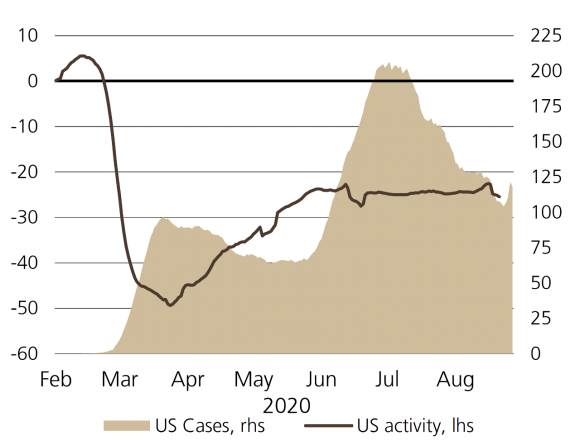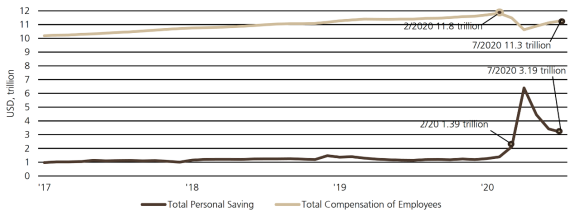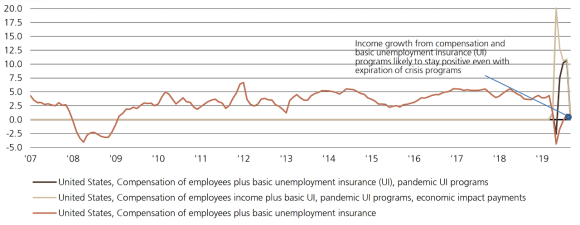Macro Quarterly Bridging the gap to a broader recovery
An ongoing struggle continues between virus-induced impairments to economic activity and the powerful policy response continues to dominate the economic backdrop.
Evan Brown, Head of Multi-Asset Strategy Investment Solutions

Highlights
Highlights
- Vaccine development and the ongoing fiscal response (which the upcoming US election may heavily impact) are the critical themes that will shape the timing and strength of the economic normalization process.
- We expect emergency approval of 1-3 vaccines in Q4 2020 and broad availability in mid-2021.
- The outlook for US and global growth remains positive even in the absence of additional fiscal support.
- We favor cyclical, value, and emerging market exposures on increased confidence in the durability and broadening of the early-cycle environment.
- Investors should focus on the totality of policy changes in assessing US election outcomes, not merely the tax implications.
An ongoing struggle between virus-induced impairments to economic activity and the powerful policy response continues to dominate the economic backdrop. The coming months should start to answer the lingering questions on these defining features of 2020. While cognizant of the downside risks, we expect the outcomes will help bridge the gap to a broadening recovery.
There is good news and bad news on the relationship between infection levels and high-frequency, economically-sensitive mobility data in the US and Europe. On the plus side, rising case counts after the initial peak failed to cause a pronounced rollover in activity, as better public health behaviors allowed for a cautious reopening process to continue. This provides confidence that additional waves of the virus may not necessarily elicit a return to economic contraction. On the other hand, the persistent threat to public health still results in a substantial shortfall in mobility relative to the pre-pandemic baseline. A durable return to pre-COVID-19 levels and patterns of economic activity is contingent upon the development and distribution of an effective, trusted vaccine.
We see the principal sources of two-sided uncertainty in the economic outlook as the timeline for a vaccine and changes in the fiscal impulse that can expedite this recovery or put it in jeopardy.
The surprisingly strong global growth recovery is shifting into a lower gear, in line with our expectations. But even with moderating economic momentum, our view of the medium-term picture for financial markets remains constructive. Risk assets are looking ahead to a continuation of growth going forward, thanks in part to optimism on vaccine development. Earnings are poised to rise while the discount rate remains subdued, a function of the Federal Reserve’s structurally more dovish flexible inflation targeting framework. This approach is designed to amplify existing monetary accommodation as the expansion strengthens, which should cap real yields and weigh on the US dollar. A robust pace of growth in China’s credit impulse and the striking rally in the CRB Raw Industrial Metals index are leading indicators of a solid foundation for real activity, particularly in the goods sector and EM. And in Europe, many nations have extended furlough subsidy programs, a useful backstop for incomes and spending. The EU Recovery Fund ensures that some degree of fiscal support will persist next year.
Following the recent correction, we are looking to tactically add risk and favor more economically sensitive sectors and regions. The ongoing early-cycle environment remains fertile ground for a mix of cyclical positions that are already trending positively or have asymmetric catch-up potential as the global economy heals. We see a suite of attractive relative value opportunities across asset classes, with a preference for trades consistent with a broadening of risk appetite on enhanced investor conviction in the process of durable economic normalization. We believe that vaccine progress and the fiscal thrust will drive the timing, magnitude, and longevity of the success in the early-cycle opportunity set.
Exhibit 1: US COVID-19 cases vs. activity data
Exhibit 1: US COVID-19 cases vs. activity data

Exhibit 1a: EU COVID-19 cases vs. activity data
Exhibit 1a: EU COVID-19 cases vs. activity data

Vaccine catalyst coming
Vaccine catalyst coming
The pent-up demand that has some industries operating at or above pre-COVID-19 levels should fade, sharpening focus on the development of vaccines required to allow for the repair of more chronically afflicted businesses. Multiple prominent candidates are in Phase 3 trials. Importantly, many of these potential vaccines employ fundamentally different development processes, diversifying against the risk that one particular vaccine or type of delivery mechanism fails to pan out.
We expect emergency approval of one to three vaccines during Q4 2020, first by the US Food and Drug Administration (FDA) and then closely thereafter by European regulators, with more in the months to follow. First responders, other essential workers, and at-risk segments of the population will be the primary recipients at that time. We expect full approval that allows for broad inoculation to begin by the middle of 2021.After emergency approval, a diverse cohort of vaccinated individuals must be monitored prior to full approval and general availability. Time is also necessary to overcome bottlenecks to production capacity for both the vaccine and its storage and distribution components, such as glass vials and refrigerators.
Exhibit 2: China credit impulse and industrial metal prices picking up
Exhibit 2: China credit impulse and industrial metal prices picking up

Exhibit 3: Tech dominance to diminish
Exhibit 3: Tech dominance to diminish
Nasdaq 100 earnings, price outperformance should turn on recovery, reopening progress

At the index level, global equities appear to have priced in an approval and administration process roughly in line with our base case. However, we expect the announcement of an approval will help spark rotation within equities, reversing a regime dominated by exceptional gains for the few – mega-cap tech firms – relative to the many, particularly cyclical and value stocks. Within US equities, the fundamental tide is turning in favor of broader equity exposure compared to the tech-heavy Nasdaq 100. A vaccine announcement is likely to reinforce this trend by increasing visibility into the earnings recovery outside of technology and other work-from-home beneficiaries. In addition, it should also catalyze the next phase of US dollar weakness in which undervalued, higher-beta emerging market currencies meaningfully outperform.
However, a vaccine will not be broadly available by winter in the US and Europe, a time when experts fear a seasonal resurgence of the virus. There is uncertainty about how much protection any vaccine might offer, how long it would last, and what protective safeguards need to remain in place as it is distributed. Vaccine dissemination may also contribute to an uneven, gradual recovery across geographies, as access for emerging market economies outside of China and Russia is likely to lag that of developed nations.
Fiscal follow-through?
Fiscal follow-through?
Most of the identifiable near-term threats to the recovery remain intertwined with public health outcomes, chiefly vaccine development, and government policy decisions. The prospect of a severe, seasonal second wave of COVID-19 across the developed world could necessitate a return to lockdowns and reverse the economic progress since April. The drop-off in fiscal stimulus stateside reintroduces an element of two-way economic risk after the initial powerful policy response cut off the left tail of adverse economic outcomes.
But we have not ruled out the potential for a US fiscal package of at least USD1.5 to USD 2 trillion by early October. If there is a deal, it is likely to be substantial in size in order to encompass priorities from both President Donald Trump and House Majority Leader Nancy Pelosi. Investor expectations for any additional fiscal stimulus have diminished thoroughly. As such, any success on this front would bolster the appeal of our preferred pro-cyclical, value positions in the equity market.
Even if this does not come to pass, going over the fiscal cliff need not result in a US economic plateau. To date, the economic recovery has been robust. We believe that income growth is likely to remain positive. Previous rounds of fiscal assistance and provisional measures continue to buttress the economic outlook. In aggregate, households have more than three months of excess savings to smooth lost wages (see Exhibit 4). And even absent an increase in the total compensation of employees in August, combined labor income plus basic unemployment insurance payments would still post positive growth on an annual basis. The distribution of lump sum payments in September to unemployed Americans as part of the Lost Wages Assistance program should also serve as an effective stopgap measure to buoy incomes and spending.
The November presidential and Congressional election may redefine the US fiscal outlook. A Blue Wave could lead to a substantial green infrastructure push and tax increases. Retaining the status quo of a Trump presidency and divided Congress would likely see the continuation of deregulatory policies and trade disputes. A Biden win and split Congress could mitigate fears of higher taxes but also result in a fiscal impasse that weighs on the nascent US expansion in 2021 and beyond. Polling data and prediction markets suggest the most likely outcomes are relatively positive for international equities and negative for the US dollar, which would offer an additional tailwind for many of our preferred positions. We will discuss the election outlook and market implications in more depth in the October edition of Macro Monthly.
Exhibit 4: Higher household savings still able to cushion shortfall in compensation
Exhibit 4: Higher household savings still able to cushion shortfall in compensation

Our conviction is that continued fiscal stimulus is necessary to ensure a vigorous economic recovery. As such, we caution against narrowly focusing on the higher taxes that would likely accompany a Blue Wave and failing to appreciate the offset that would be provided by presumed significantly higher spending. The net result would not be a material and prolonged negative for the entire universe of US assets, particularly the more cyclically-oriented. Investors often err in presumptions about whether a certain politician or set of policies has positive or negative market implications. For instance, the most powerful measure in the CARES Act that supported the outlook for consumer spending, and in turn, US stocks, was enhanced unemployment benefits. The politician that insisted on this measure is the same one that investors feared would be the most market-unfriendly potential president: Vermont Senator Bernie Sanders.
2020 vision, at last
2020 vision, at last
The highly irregular end to one economic expansion and beginning of another will increasingly start to look more like a normal cycle over time. Our expected cyclical recovery is unevenly embedded across asset classes, based on the degree of retracements across financial markets relative to pre-COVID-19 peaks and the ensuing troughs.
Within equities, we prefer pockets outside of the US, in particular emerging markets. This is informed in part by our belief that the softness in the US dollar will persist, as real yields remain steeply negative. The rise in gold also has more room to run.
Emerging market currencies, particularly in Latin America, stand out as particularly attractive to us as Chinese stimulus filters through to support global activity. There has been a limited recovery in many of these currencies despite more signs of success in controlling the spread of the virus, and they continue to trade at compelling valuations. A lack of volatility-adjusted carry relative to previous cycles may limit the length and extent of the appreciation.
Exhibit 5: US income support measures provided a bridge, even if phased out
Exhibit 5: US income support measures provided a bridge, even if phased out
Assuming flat compensation in August, income growth poised to slow sharply but stay positive

Exhibit 6: Asset retracement of COVID-19 move
Exhibit 6: Asset retracement of COVID-19 move

One clear outlier is the lack of retracement to the upside in longer-term Treasury yields. We expect the Treasury curve to steepen, with longer-term bonds likely to sell off on the announcement of additional fiscal stimulus. In our view, a brisk return to pre-COVID-19 levels is not in the cards due to credibly, dovish forward guidance from the Federal Reserve that should limit the rise in real yields even as breakevens trend higher.
2020 has been a year marked by astonishing economic and financial market volatility, and its final act will start to provide a welcome resolution. The announcement of a COVID-19 vaccine, potential for additional fiscal stimulus, and the results of the US election are the key events that will facilitate a convergence in expectations for the timetable and relative strength of the US and global economic expansions.
Asset class attractiveness
The chart below shows the views of our Asset Allocation team on overall asset class attractiveness, as well as the relative attractiveness within equities, fixed income and currencies, as of 17 September 2020.

